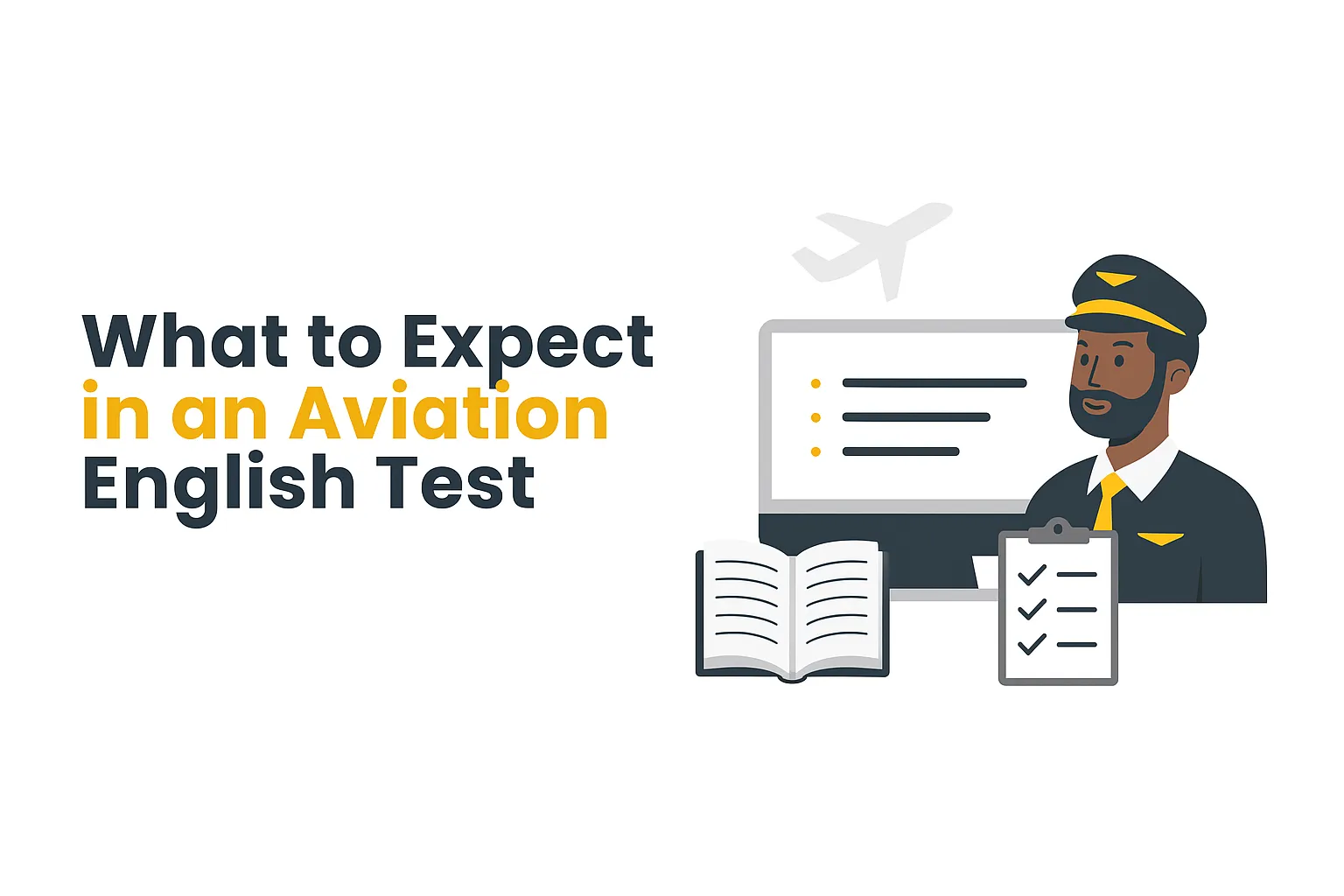The Aviation English test is a cornerstone of international aviation safety, ensuring that pilots, air traffic controllers, and other professionals can communicate effectively in English, the global language of aviation. Mandated by the International Civil Aviation Organization (ICAO), these tests assess language proficiency to prevent miscommunication in critical situations. Whether you’re a student pilot, a licensed professional, or an air traffic controller, understanding the structure and components of an Aviation English test is key to passing with confidence. At icaospeak.com, we offer accredited online ICAO English tests and comprehensive preparation resources to help you succeed. This in-depth guide breaks down what to expect in an aviation English test, including its format, assessment criteria, preparation tips, and more, so you can approach it with clarity and assurance.
Why Aviation English Tests Are Essential
Effective communication is vital in aviation, where clear instructions can mean the difference between safety and disaster. The ICAO introduced Language Proficiency Requirements (LPRs) in 2008 to standardize English skills for international operations, as outlined in ICAO Doc 9835. These requirements ensure that aviation professionals can handle routine and non-routine situations, such as emergencies or complex air traffic control (ATC) communications. The Aviation English test evaluates six key skills, pronunciation, structure, vocabulary, fluency, comprehension, and interactions, on a scale from Level 1 to Level 6, with ICAO Level 4 being the minimum for operational use.
At icaospeak.com, our online ICAO English test is fully compliant with ICAO and EASA standards, making it a trusted choice for pilots and controllers worldwide. Whether you’re aiming for ICAO Level 4, Level 5, or Level 6, understanding the test’s structure is the first step to success. Ready to get started? Schedule your test today.
Structure of an Aviation English Test
The Aviation English test, often referred to as the ICAO English Proficiency test, is designed to simulate real-world aviation communication scenarios. It typically lasts 20–30 minutes and is conducted either in-person or online, with platforms like icaospeak.com offering a fully digital experience via Zoom and a dedicated language assessment platform. Below is a detailed breakdown of the test’s components, based on ICAO guidelines and industry standards.
1. Introductory Conversation
The test begins with a brief interview, where the examiner asks about your aviation background, experience, and role (e.g., pilot, air traffic controller). This section assesses your ability to engage in general conversation and sets the tone for the test.
- Purpose: Evaluate fluency, vocabulary, and interactions in a casual setting.
- Duration: 3–5 minutes.
- Example Questions:
- What inspired you to become a pilot?
- Describe your typical day in aviation operations.
2. Listening Comprehension Tasks
This section involves listening to aviation-related recordings, such as ATC communications, pilot exchanges, or emergency scenarios. You’ll need to understand and respond to these recordings, demonstrating your ability to comprehend spoken English in operational contexts.
- Purpose: Test comprehension and listening skills under pressure.
- Duration: 10–12 minutes.
- Examples:
- Respond to an ATC clearance, such as “Cleared to land runway 27R.”
- Summarize a recorded emergency situation, like a weather deviation request.
3. Speaking and Interaction Tasks
The speaking section includes role-playing and descriptive tasks that mimic real-world aviation scenarios. You may be asked to describe images, explain procedures, or engage in simulated ATC dialogues.
- Purpose: Assess pronunciation, structure, vocabulary, fluency, and interactions.
- Duration: 10–15 minutes.
- Examples:
- Describe an aviation-related image, such as a cockpit or runway.
- Role-play a scenario, like requesting a diversion due to low fuel.
4. Non-Routine Scenarios
To test your ability to handle unexpected situations, the examiner may introduce non-routine scenarios, such as equipment malfunctions or medical emergencies. This evaluates your ability to communicate clearly under stress.
- Purpose: Measure adaptability and clarity in high-pressure situations.
- Duration: Integrated into speaking tasks.
- Examples:
- Explain how you’d communicate a hydraulic failure to ATC.
- Discuss a hypothetical weather-related diversion.
For a realistic practice experience, try our mock tests priced at €69, which simulate these components with live feedback from certified examiners.

Assessment Criteria: ICAO’s Six Language Skills
The aviation English test evaluates candidates based on the ICAO Language Proficiency Rating Scale, which includes six skills. Each skill is scored from Level 1 (Pre-Elementary) to Level 6 (Expert), with Level 4 (Operational) being the minimum for international operations. Here’s a detailed look at each skill:
| Skill | Description | What Examiners Look For |
| Pronunciation | Clarity and accuracy of spoken English, considering accents. | Clear speech, minimal accent interference, and effective communication. |
| Structure | Grammatical accuracy and sentence complexity. | Correct grammar, appropriate sentence structures, and error-free communication. |
| Vocabulary | Range and accuracy of aviation-specific and general terms. | Use of precise aviation English vocabulary, such as “clearance” or “holding pattern.” |
| Fluency | Smoothness and natural flow of speech. | Consistent speech pace, minimal hesitation, and natural delivery. |
| Comprehension | Ability to understand spoken English, including ATC recordings. | Accurate interpretation of instructions and scenarios, even in noisy conditions. |
| Interactions | Ability to engage in dialogue and respond appropriately. | Effective responses, turn-taking, and clarity in two-way communication. |
Achieving ICAO Level 4 requires at least a Level 4 score in all six skills, with retesting required every 4–6 years depending on the level achieved. For detailed insights, explore our guide to ICAO English levels.
What to Expect During an Online Aviation English Test
Online aviation English tests, like those offered at icaospeak.com, follow the same structure as in-person tests but are conducted via secure video conferencing platforms. Here’s what you can expect:
- Technical Setup: You’ll need a stable internet connection, a quiet environment, and a device with a webcam and microphone (e.g., laptop or smartphone). We provide detailed setup instructions to ensure a smooth experience.
- Test Delivery: The test combines a live Zoom interview (10–15 minutes) with a semi-direct portion (18 questions, 20–25 minutes) on our language assessment platform.
- Examiner Interaction: Certified examiners, often with aviation experience, conduct the test, ensuring a professional and supportive environment.
- Results Timeline: Receive your results within 3 business days, delivered via email with official documentation.
Our online format is fully compliant with EASA Part FCL.055 and ICAO Doc 9835, ensuring global recognition. Ready to experience it? Book your online ICAO English test.
How to Prepare for the Aviation English Test
Preparation is key to passing the Aviation English test and achieving your desired ICAO English proficiency level. Here are actionable tips to help you succeed:
1. Understand the Test Format
Familiarize yourself with the test’s structure by reviewing sample questions and scenarios. Our blog on ICAO English sample questions provides examples to get you started.
2. Build Aviation English Vocabulary
Learn key terms like “squawk,” “go-around,” and “clearance,” which are commonly used in ATC communications. Our aviation English vocabulary guide offers a comprehensive list.
3. Practice Listening Skills
Listen to real ATC recordings or podcasts, such as those available on LiveATC.net, to improve comprehension. Practice summarizing what you hear to prepare for listening tasks.
4. Improve Speaking and Fluency
Engage in role-playing exercises with a partner or instructor to simulate ATC dialogues. Our 1-on-1 training sessions at €29 per hour provide personalized coaching with aviation experts.
5. Take a Mock Test
Simulate the test experience with our mock tests, which include live feedback to identify areas for improvement.
6. Focus on Non-Routine Scenarios
Practice responding to unexpected situations, such as engine failures or weather deviations. Our preparation courses include exercises for these scenarios.
For a structured approach, check out our week-by-week preparation plan.
Common Challenges and How to Overcome Them
Candidates often face challenges during the aviation English test. Here’s how to address them:
- Nervousness: Practice in a simulated environment to build confidence. Our mock tests help reduce test-day anxiety.
- Accent Issues: Focus on clear pronunciation, as accents are acceptable as long as they don’t hinder communication. Our pronunciation tips can help.
- Limited Vocabulary: Study aviation-specific terms and phrases. Refer to our vocabulary guide.
- Difficulty with Non-Routine Scenarios: Practice role-playing complex situations with an instructor. Our 1-on-1 training is tailored for this.
Comparison: Online vs. In-Person Aviation English Tests
To help you decide, here’s a comparison of online and in-person aviation English tests:
| Aspect | Online Test | In-Person Test |
| Location | Anywhere with internet | Designated testing center |
| Scheduling | Flexible, multiple slots | Limited, fixed schedules |
| Cost | Lower, e.g., €169 at icaospeak.com | Higher, includes travel costs |
| Convenience | High, test from home | Lower, requires travel |
| Accessibility | Global, no geographic barriers | Limited by center locations |
| Results | Quick, within 3 days | May take weeks |
| Technology | Zoom and assessment platforms | In-person proctoring |
Online tests offer clear advantages, especially for busy professionals. Learn more about the benefits of online ICAO English tests.
Why Choose icaospeak.com for Your Aviation English Test
At icaospeak.com, we are committed to helping you achieve your ICAO English certification with ease. Here’s why we stand out:
- Accredited and Recognized: Our tests meet ICAO and EASA standards, accepted by aviation authorities worldwide.
- Experienced Examiners: Our team includes certified aviation English instructors with real-world aviation experience.
- Affordable Pricing: Test for €169, mock tests for €69, and 1-on-1 training for €29 per hour.
- Fast Results: Receive your score within 3 business days, with official documentation.
- Comprehensive Support: Access mock tests, courses, and personalized coaching to ensure success.
Explore our services and see why pilots trust us.
Frequently Asked Questions
1. What is the duration of an Aviation English test?
The test typically lasts 20–30 minutes, covering introductory, listening, and speaking tasks.
2. What level do I need to pass?
ICAO Level 4 is the minimum for operational use, with retesting required every 4–6 years depending on your level.
3. Are online tests as valid as in-person tests?
Yes, our online tests are fully accredited by ICAO and EASA. Check our compliance details.
4. How can I prepare effectively?
Use our mock tests, training sessions, and sample questions.
5. What happens if I don’t pass?
You can retake the test anytime. Contact us at icaospeak.com/contact for guidance.
External Resource
For official ICAO guidelines, visit ICAO’s Language Proficiency Requirements.
Conclusion
The Aviation English test is a critical step for aviation professionals seeking to meet ICAO language proficiency standards. By understanding its structure, introductory conversation, listening tasks, speaking exercises, and non-routine scenarios, you can prepare effectively and approach the test with confidence. At icaospeak.com, we make the process seamless with accredited online tests, expert examiners, and comprehensive resources like mock tests and 1-on-1 training.
Don’t let uncertainty hold you back. Schedule your Aviation English test today and take the first step toward your ICAO English certification. Need help preparing? Explore our courses or contact our team for personalized support. Your aviation career deserves clear communication, start now!
